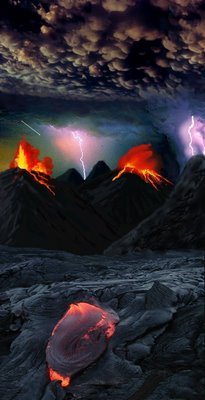Hadean
 Based on radio-dating of meteorites, the solar system is about 4600 Ma (4600 million years), or 4.6 billion years old (Ga). Condensation of the solar system from a large, hot accretion disk occurred about 10 Ga after the Big Bang.
Based on radio-dating of meteorites, the solar system is about 4600 Ma (4600 million years), or 4.6 billion years old (Ga). Condensation of the solar system from a large, hot accretion disk occurred about 10 Ga after the Big Bang.When early Earth was cooling from its molten state, conditions would have been like hell on Earth – hence the term "hadean" for this earliest segment, or eon, of the Precambrian. Meteors rained down on the hot Earth, ultraviolet radiation was unchecked by an ozone belt, and volcanos belched fumes into a reducing atmosphere, which sparked with lightning.
The term "hadean" was coined to designate the time before the earliest known rocks. However, rocks have been found that are older than the time-frame of the Hadean.
Life, of course, had not yet arisen by biopoiesis, but it probably had an earlier start than thought previously.
The Hadean Eon extends from Earth's formation to 3.8 billion years ago (Ga) and is succeeded by the Archean Eon (not to be confused with prokaryotic Archaea), which lasts until 2.5 Ga. The Proterozoic Eon next extends from 2.5 billion years ago to 540 million years ago, and is succeeded by the Phanerozoic ('visible life') Eon.
αΩ Beginning αΩ Geological Time αΩ Ediacara ▫ site map
tags [Evolution] [Hadean Eon]
Labels: earliest rocks, Hadean eon







































